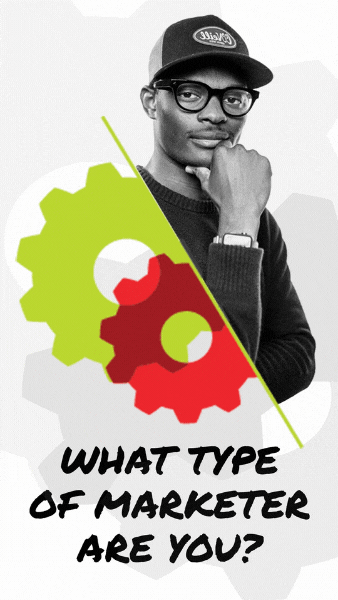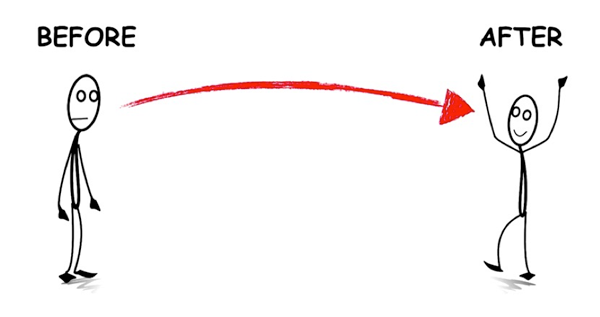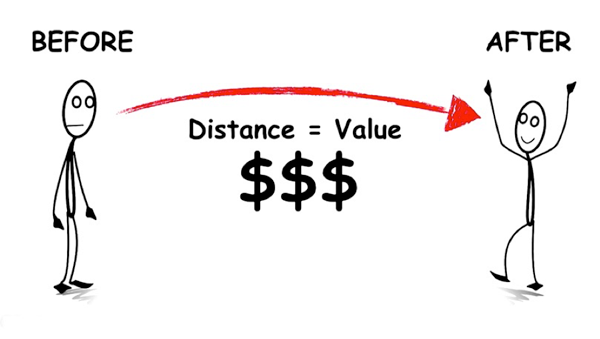

You’ve finally found it…
The “treasure map” to building an unstoppable business.
We call it the Customer Value Optimization process.
(RELATED: Conversion Funnel Mastery)
If you’re not familiar with how we do things here at DigitalMarketer, this is the first article you should read. It teaches you the foundational principles of digital marketing.
And even if you’re a salty DM veteran, you might still want to reread this from time to time as a refresher. It’s that important.
What you’re about to get in this post is a 10,000-foot view of how the marketing process works when it’s done right.
This is vital to understand because all marketers and entrepreneurs are at various levels of STUCK. There’s so much to learn—and the marketing space is changing so rapidly—that no one can keep up with every little shift in the market.
But when you understand the big-picture view…
When you can see how all the different pieces are meant to work together…
You’ll know how to create a SYSTEM that works to efficiently and repeatedly attract new prospects, convert them into customers, and get the maximum profit out of them.
Sound like something you’d like to have? Then let’s get right to it.
The System
This is the system Starbucks and McDonald’s used to corner the coffee and hamburger markets. It’s the same system Amazon uses to dominate ecommerce. It’s how Best Buy, Beachbody (selling workouts like P90X), and Sports Illustrated have become household names.
It works for small, medium, and enterprise-level businesses. It works for mom-and-pop shops and billion-dollar retailers. It works whether you sell traditional products, digital products, or services.
This system works because it exploits each and every aspect of the irrefutable law of business growth put forth by legendary marketer Jay Abraham. He teaches that there are only 3 ways to grow a business:
- Increase the number of customers
- Increase the average transaction value per customer
- Increase the number of transactions per customer
If you think about it, this makes perfect sense.
And the system you’re about to learn—we call it Customer Value Optimization or CVO—leverages all 3 business growth methods. That’s what makes it so powerful.
So read this page carefully. Read it multiple times, and commit it to memory.
This is the stuff the world’s best marketers and entrepreneurs know and use daily—but it isn’t taught in any business school.
Learn the Steps to Customer Value Optimization
This handy flowchart outlines the CVO system: Download a PDF version of the chart here
Print this PDF and tack it to the wall next to your work station. If you intend to execute this plan, you’ll need to reference it often.
This is your big-picture treasure map to building an unstoppable business. Anytime you’re learning a new tactic—whether it’s Facebook marketing, Google Analytics, search engine optimization (SEO), and so on—you’ll want to check in to see which part of the Customer Value Optimization process that tactic fits into.
Otherwise, you’re liable to end up wasting your time and money.
Take this as a WARNING: There is little profit in understanding, for example, Pinterest advertising or email marketing in and of itself. Because individual tactics like that represent just one piece of the whole.
But there is an ENORMOUS profit in understanding how to apply these traffic strategies within the context of the CVO process.
Here is a flowchart of the entire Customer Value Optimization system:


When you break it down, there are 7 steps to Customer Value Optimization:
- Determine Product/Market Fit
- Choose a Traffic Source
- Offer a Lead Magnet
- Offer a Tripwire
- Offer a Core Product
- Offer a Profit Maximizer
- Create the Return Path
Lean into this article and pay close attention—we’re about to reveal the EXACT process we use to sell products and services in multiple niche markets and mainstream verticals including…
- Finance and Investing
- Men’s Clothing
- Home Improvement
- Survival and Preparedness
- Beauty
… just to name a few.
Let’s begin with…
Step 1: Determine Product/Market Fit
We begin the Customer Value Optimization process by getting clear on the most important person in your business: your customer.

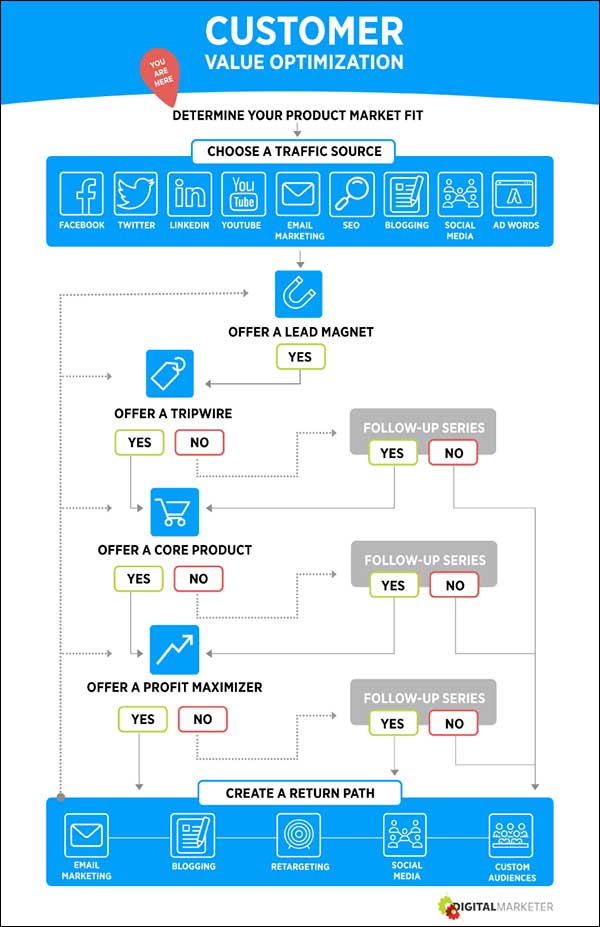
At its core, business is pretty simple.
We get paid to move these customers from an undesirable “Before” state to a desirable “After” state.
In the “Before” state, the customer is discontent in some way. They might be in pain, bored, frightened, or unhappy for any number of reasons.
In the “After” state, life is better. They are free of pain, entertained, or unafraid of what previously plagued them.
People don’t buy products or services…
They buy transformations.
AKA outcomes.
AKA a more desirable “After” state.
This means that a good OFFER will deliver the “After” state the person wants…
And good MARKETING will articulate that transformation from “Before” to “After.”
The flip side is also true: when a new business fails, it’s often because it FAILED to either…
- Offer a desired “After” state (the offer was no good)
- Articulate the movement from “Before” to “After” (the marketing was no good)
Needless to say, getting clear on the desired outcome your offer delivers is fundamental to the success of your business.
Here’s how to get that clarity…
The 10-Question “Before & After” Grid
Before you create or market another offer, ask yourself these 10 questions:
- What does your prospect HAVE in the “Before” state? What does your prospect HAVE in the “After” state?
- How does your prospect FEEL in the “Before” state? How does your prospect FEEL in the “After” state?
- What is an AVERAGE DAY like for your prospect in the “Before” state? What is an AVERAGE DAY like for your prospect in the “After” state?
- What is your prospect’s STATUS in the “Before” state? What is your prospect’s STATUS in the “After” state?
- What is an EVIL that is plaguing the prospect in the “Before” state? How does your prospect conquer it and bring more GOOD to the world in the “After” state?
Just put your answers in a simple table like this:


Here’s an example, using our own company DigitalMarketer. How do we help our customers achieve a positive transformation in their lives?
For this example, we’re going to use our “Marketing Executives” avatar. So these people are in charge of a marketing department—usually the CMO, the VP of Marketing, or the Director of Marketing.
We know from experience that people in these positions run into a lot of problems. A lot of undesirable “Before” states. So, we’ve created training programs that can help solve those problems and deliver the “After” states these people really want.
How do we do it? By transforming the marketing executive…
- From HAVING a disorganized team… to having a team that’s a well-oiled machine
- From FEELING frustrated, overwhelmed, and scared of losing their job… to feeling confident and in control
- From having an AVERAGE DAY in which they have to “coach up” under-performing team members… to an average day in which they’re free to focus on big-picture strategy because they can trust their other team members to take care of the details correctly
- From a STATUS of being disrespected and behind the times… to a status of being respected, up-to-date, and even up for a promotion
- From the EVIL of being a victim of an old-school university model that doesn’t prepare graduates for the realities of marketing today… to the GOOD of helping to train the marketing leaders of the future

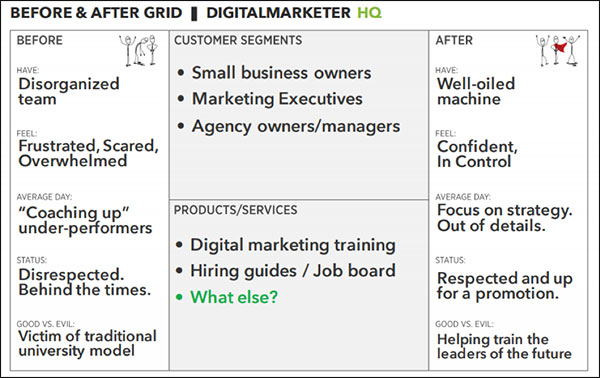
Average marketers only articulate what a customer will HAVE if they purchase their product or service.
Great marketers speak to the transformations around how the customer will FEEL, how their AVERAGE DAY will change, how their STATUS will elevate, and how they will solve an EVIL in the world (making them a real-life hero).
With this simple 10-question “Before & After” Grid, any half-decent copywriter will be able to create a marketing message that will have an impact.
The marketing copy writes itself now that you are clear on the “Before” and “After”…
- “Turn your disorganized team into a well-oiled machine that’s ready to kick some serious marketing butt.”
- “Tired of having to ‘coach up’ your team day after day? With DigitalMarketer HQ, you’ll be free to step back and focus on big-picture strategy.”
- “Just imagine feeling confident and respected in meetings, knowing that your next promotion is coming soon.”
Do you see how this copy clearly articulates how the product will move a marketing executive from a “Before” state of stress and frustration to an “After” state of confidence and success?
It’s powerful stuff.
Make sure to complete the Before & After Grid for ALL of your customer avatars, because each customer segment will go through a different transformation.
Understanding how you will transform your prospect from a “Before” state to a desired “After” state also impacts…
How much you can charge
What is the distance between the “Before” and desired “After” state?
That distance is called VALUE.
A stick of gum is inexpensive, in part, because it covers a very short distance—from “bad taste in your mouth” to “good taste in your mouth.”
By comparison, a car covers a much greater distance: from “stuck at home” or possibly “forced to take a crowded bus to work” to being “free to travel wherever you want in privacy and comfort.” The car provides much more value, and accordingly, it’s also a lot more expensive.
Do you want to charge more for your products and services?
If so, the solution is simple: create more distance between the “Before” and desired “After” state by either:
- Creating a better product or service (better offer)
- Articulating the movement from “Before” to “After” differently or more clearly (better marketing)
When rolling out a new offer, starting a new company, or moving into a new market—make sure to get clear on your “Before” and “After” states. And as I said, make sure to do it for EACH of your customer avatars.
(RELATED: Learn more about what a customer avatar is—and how to create your own—HERE!)
If you’re not able to clearly articulate how you can take your prospect from the “Before” state to a desired “After” state… you may have an issue with Product/Market Fit.
Product/Market Fit may be the single most important part of the entire Customer Value Optimization system. Simply, because every other part of the process is dependent upon having a group of willing and able buyers.
Once you have that group of buyers, the next step is to find a way to bring those people to your website. Which brings us to Step 2: Choose a traffic source.
Step 2: Choose a Traffic Source
Now that you’ve achieved Product/Market fit, your next step is to figure out how to reach that market and get them to your website.
This is where paid traffic comes into play.

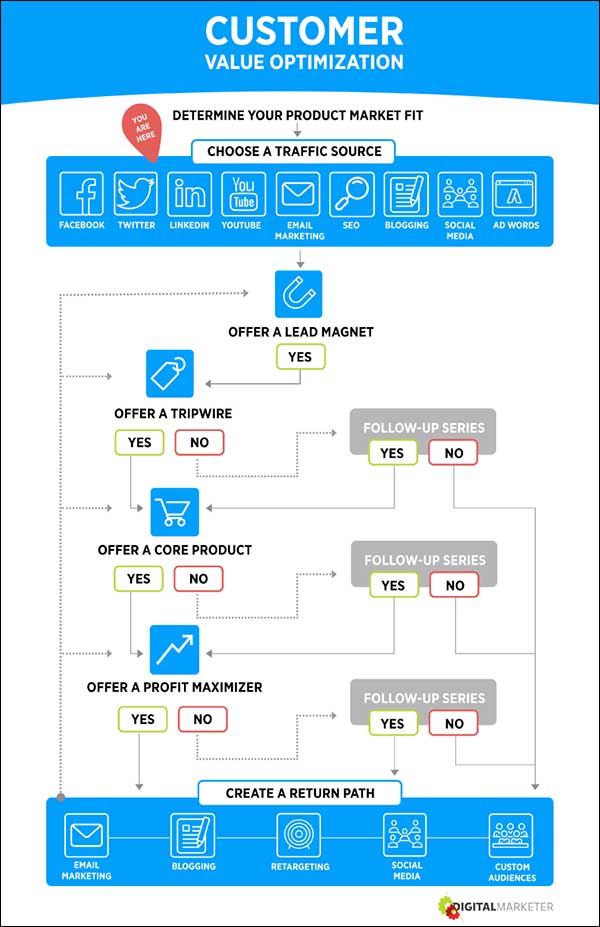
I’ve often said that in this day & age, NOBODY has a traffic problem.
You might have a business model problem, an offer problem, or a measurement problem.
But traffic is NOT your problem.
Want to know why?
You can always buy more traffic.
Google, Facebook, Pinterest, Twitter, and LinkedIn… these platforms are all essentially traffic stores. And they would love to send you more clicks (for the right CPC or CPM, of course).
When you look at it that way, the question of traffic comes down to cost. And to generate traffic profitably, you simply need to understand 2 things:
- How to measure what traffic is worth
- How to extract maximum immediate value from that traffic
For example, pretend that you got $10 in profit every time a visitor came to your website. Would you be able to get traffic to the site?
Heck yes, you would!
You could pay up to $10 per visitor and still break even.
In fact, you’ll be able to pay MORE than $10 to get a visitor to that page when you truly understand the whole Customer Value Optimization system—because you’ll be able to extract even more profit from those visitors later on.
This is why CVO is so powerful. Because it allows you to earn more profit per visitor…which means you can spend more money per visitor.
I’ve often said:
“He who can spend the most money to acquire a new customer… wins.”
And Jeff Bezos, Founder and CEO of Amazon.com, once said something similar (in a tongue-in-cheek warning to his competitors):
“Your margin is my opportunity.”
Amazon.com sells on the thinnest of margins, knowing that acquiring new customers, selling them more products, and selling to them more frequently is how you become unstoppable (there’s Jay Abraham’s law of business growth again).
Now THAT is a killer traffic strategy—one that sets you up for long-term profits and steady growth.
And this is also why tactics and “marketing hacks” are worthless if you don’t understand the CVO process.
You can learn about blogging, Facebook ads, or email marketing until you’re blue in the face…but unless you know how to set up a system that wrings maximum profit from that traffic, you’ll continue to be frustrated.
That’s because the goal of traffic generation—no matter which traffic source you choose—isn’t to generate an immediate profit—it’s to drive prospects into the CVO Funnel.
So whatever you do, don’t hop around from one traffic source to the next, looking for some kind of “magic pill” that will instantly make your business profitable.
Instead, become a master of a single, steady traffic source. Stay focused on that traffic source and, once mastered, add a second and third traffic source.
These traffic sources include…
- Email marketing
- Social advertising (Facebook/Twitter/YouTube ads, etc.)
- Display advertising
- Content marketing
- Organic social media
- SEO
And so on.
You won’t make a huge profit right away, but that’s not the point. The profits will come later IF you use the CVO system.
And the next step of that system is to…
Step 3: Offer a Lead Magnet
The next 2 sections (Offer a Lead Magnet and Offer a Tripwire) show you how to grow your business through the first of Jay Abraham’s methods: increase the number of customers.
First, let’s talk about Lead Magnets.

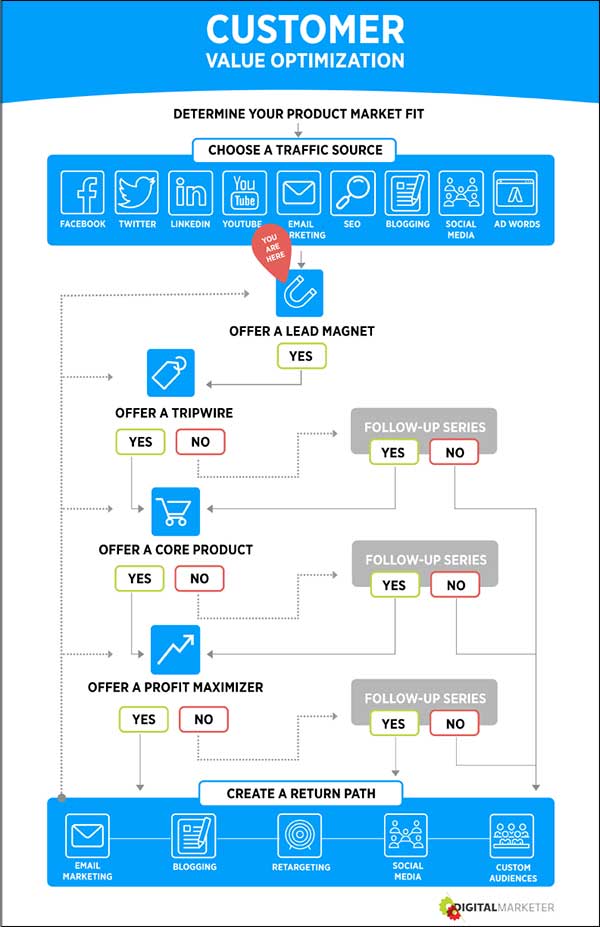
A Lead Magnet is an irresistible bribe that gives a specific chunk of value to a prospect in exchange for their contact information.
Make no mistake, although no money changes hands, this is a transaction. It is often the very first transaction you will have with a prospect.
In order for your Lead Magnet to be effective, you need to provide tremendous value with it.
The Lead Magnet is usually offered on a web page called a landing page or squeeze page that is optimized to convert even cold traffic into leads.
Your landing page doesn’t need to be fancy to be effective. Here’s a high-performing Lead Magnet landing page from Digital Marketer…

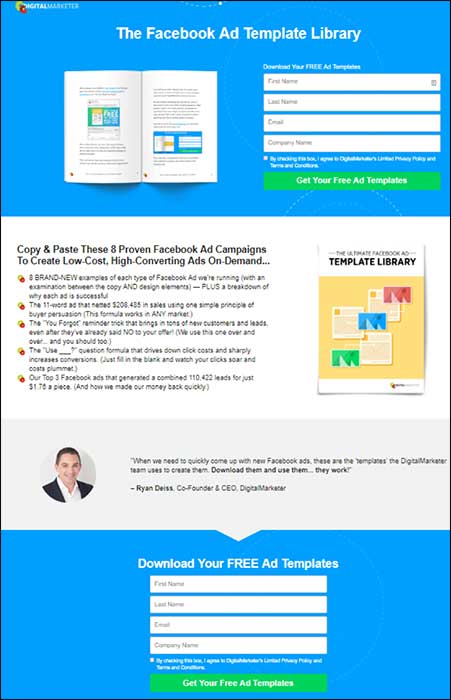
The purpose of your Lead Magnet is to generate leads so you can continue to follow up with them. Because your Lead Magnet is the very top of the CVO Funnel, increasing your opt-ins here will pay dividends throughout the rest of the system.
But not all Lead Magnets are created equal. The best Lead Magnet squeeze pages will convert north of 50% of visitors into leads.
How do you achieve such a high conversion rate?
The key is to make sure your Lead Magnet is specific.
Specificity: The Key to Getting More Leads
What irresistible bribe could you offer in exchange for a prospect’s contact information?
The good news is that you DO NOT need to create something lengthy or complex. In fact, we’ve found that the more laser-focused your Lead Magnet is…the better it will convert.
This, for example, is NOT a good Lead Magnet:

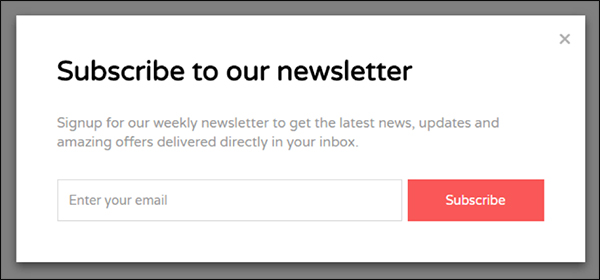
There is no offer in this Lead Magnet, much less a specific one.
But this Lead Magnet isn’t much better. There is an offer, but it isn’t specific…


The offer of a nondescript “freebie” is not going to move people to action. They want to solve a problem. They want an outcome.
(Hint: Any opt-in form or squeeze page that begins with “Subscribe to our newsletter” is probably NOT a good Lead Magnet. Just sayin’.)
Contrast the prior two Lead Magnets with the specific problem that is addressed in this Lead Magnet…

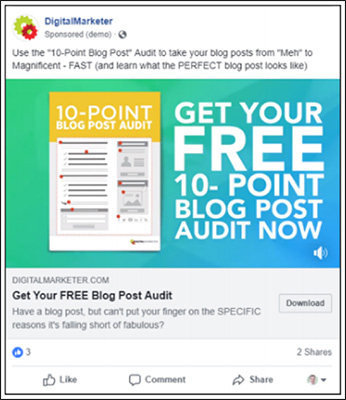
This ad gives a very specific promise to “take your blog posts from ‘Meh’ to Magnificent—FAST.”
It’s a specific promise that appeals to exactly what our customer avatar is looking for.
Now, because of the nature of our company, we tend to offer a lot of online resources—PDFs, videos, that sort of thing.
But your Lead Magnet could be all sorts of things. If you’re a SaaS company like Sprout Social, your Lead Magnet might be a free trial:


Ecommerce companies can offer free shipping or even a discount on your first purchase like Williams Sonoma does here:

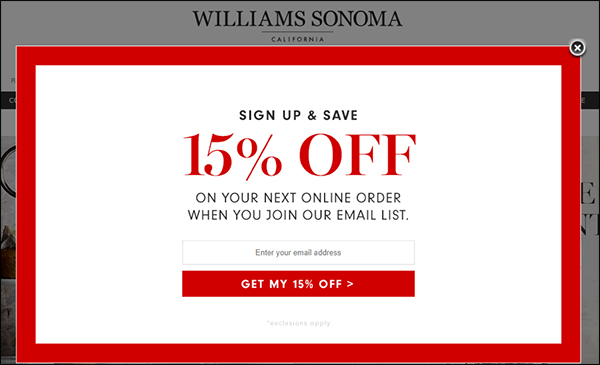
No matter what industry you’re in, the take-home message is the same:
Make sure your Lead Magnet solves a specific problem for a specific segment of the market.
Do that, and you’ll generate more high-quality leads… some of whom will then go on to take the next step in the Customer Value Optimization system.
Step 4: Offer a Tripwire
Now you have a Lead Magnet that is generating opt-ins and helping to build your email list. But your Lead Magnet isn’t generating customers, only prospects.
The next step in the CVO process is to turn those leads into customers. To do that, you need a Tripwire.


A Tripwire offer is an irresistible offer that exists for one reason and one reason only:
To convert prospects into buyers.
Typically, a tripwire is a super low-ticket offer (usually between $1 and $20), although this can depend on your market. In markets selling high-ticket products and services, a tripwire offer of $500 might be considered a low-ticket purchase.
The goal of the Tripwire is to fundamentally change the relationship from prospect to customer. The conversion of a prospect to a customer, even for $1, is magical.
The key is to make a Tripwire Offer that your leads are unable to resist.
The most common way to make the Tripwire irresistible is by selling it at cost and, in some cases, at a loss to you.
That’s correct—you are not trying to make a living from selling Tripwire Offers. You are trying to acquire buyers because there is nothing more valuable than a list of buyers.
When you understand the rest of the Customer Value Optimization process, you will understand that the Tripwire Offer is the single most powerful addition you can make to your business—even though you make no direct profit from it.
A classic example of a Tripwire Offer comes from Columbia Records…

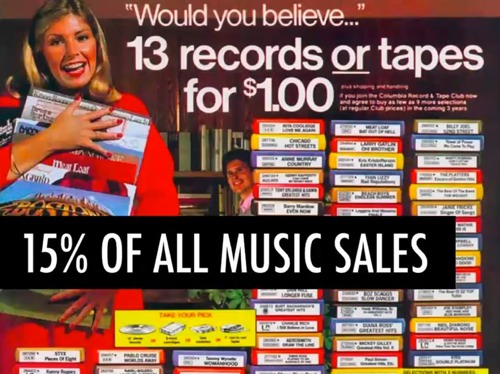
Columbia House took over the music market by making an absolutely irresistible offer (13 records or tapes for $1) because they understood that acquiring a list of buyers is the name of the game.
Types of Tripwire Offers
Physical products can make fantastic Tripwire offers…

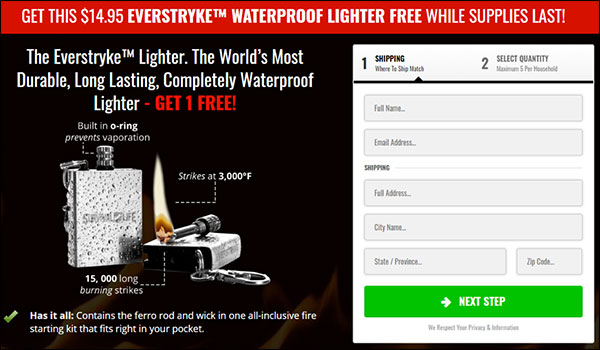
and so do physical books…

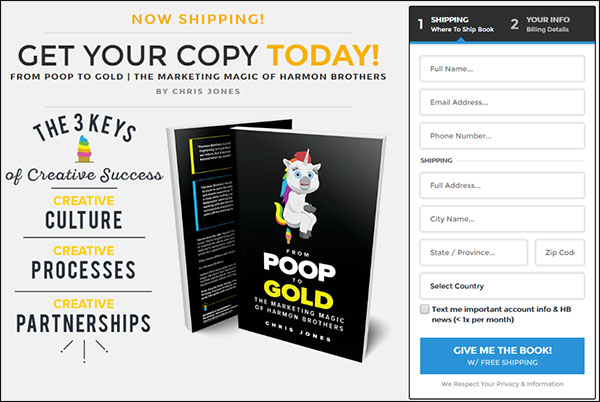
Service-based businesses will often give a steep discount on services to get new customers in the door—like dentists who offer low-cost exams or teeth whitening sessions:

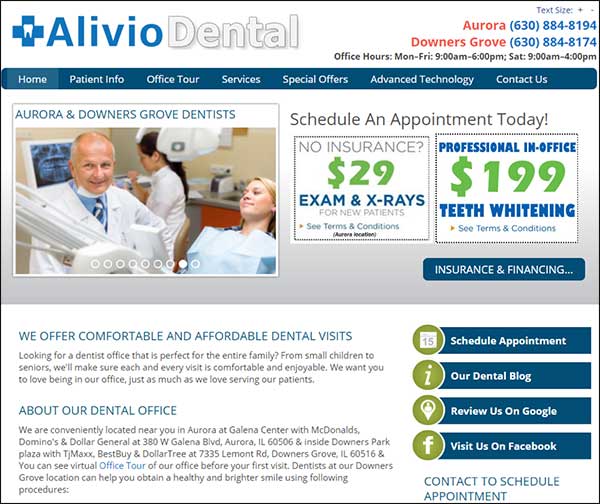
Or gyms offering a low introductory price on fitness classes…


Heck, Groupon is FULL of Tripwire offers. It’s a great place for local businesses (like salons) to attract new customers with deeply discounted offers:


Even GoDaddy, the domain registration and website hosting service, offers a low-priced domain to acquire new customers…


Tripwires are all around us.
It’s the ridiculous flat-screen TV deal at Best Buy. It’s the rock-bottom price of a Kindle Fire. It’s every service offered for a measly $5 on Fiverr.
The strategy behind the Tripwire is simple:
Convert the maximum number of Lead Magnet leads into paying customers, even at the expense of your profit margin, with the understanding that acquiring a paying customer will deliver profit through the next 3 steps:
- Core Offer
- Profit Maximizer
- Return Path
OK, now that you understand how to increase the number of customers, let’s talk about increasing the average transaction value per customer by selling your Core Product.
Step 5: Offer a Core Product
Now that you have a bunch of customers who have purchased a low-dollar item with you, the next step in the Customer Value Optimization process is to sell these people a higher-priced product.
We call that your Core Offer.


You most likely already have a Core Offer. It’s your flagship product or products.
The mistake that many businesses make is trying to sell their Core Offer to cold prospects. This almost never works, because your Core Offer is too expensive. It’s too big of a commitment for someone who’s making their first purchase with you.
That’s why we follow the CVO process to turn cold prospects into warm prospects and warm prospects into customers. Because those customers will be much more receptive to your Core Offer.
Often, simply adding a Lead Magnet and a Tripwire is enough to explode your Core Offer sales.
As long as you over-deliver and provide immense value with your Lead Magnet and Tripwire, your customers will be highly interested in purchasing your Core Offer.
And here’s something to keep in mind:
In some cases, sales from the Core Offer will make you profitable. But it doesn’t have to. If you follow through on the CVO process, you could take everything you make from the Core Offer and reinvest it to acquire more customers.
Again, this is how you become unstoppable. You build a system in which you can spend more to acquire a customer than your competitors. That means you’ll be able to acquire more customers and generate more profit in the long run through future transactions.
Compare that strategy to what most companies do—which is try to make a living from selling their Core Offer.
But you? You don’t need to make a dime from your Core Offer.
Remember, as Jeff Bezos says, your competitor’s margin is an opportunity. It is your opportunity to, for example, spend more on traffic acquisition, conversion rate optimization, or increase the value of your offers.
It might stun you to find out that many of the most successful businesses in the world make no profit until they reach the next 2 stages, Profit Maximizers and Return Path.
Here’s where things get very interesting…
Step 6: Offer a Profit Maximizer
The second of Jay Abraham’s business growth methods is to increase the average transaction value per customer.
That’s what the Profit Maximizer is for.


Most businesses don’t have Tripwire Offers and they don’t have Profit Maximizers. They live and die selling cold prospects on their Core Offer.
This is why they struggle… but you won’t.
Would it shock you to find out that McDonald’s makes almost no money on the hamburger? The hamburger is the Core Offer, but it’s the French fry and soda Profit Maximizers that built the Golden Arches.
This type of Profit Maximizer is called an immediate upsell…

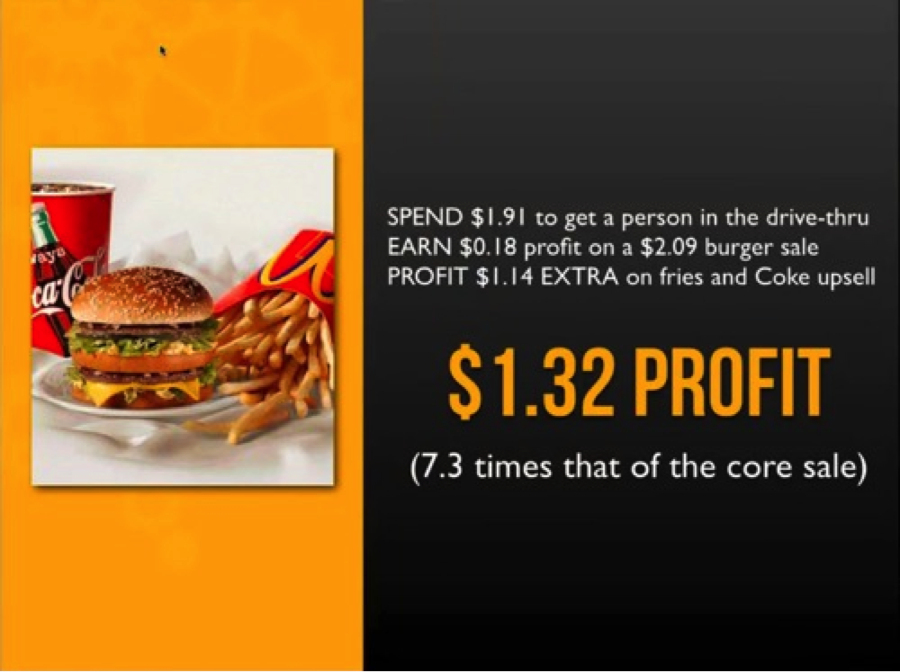
Best Buy sells laptops and plasma TVs (Core Offers) on wafer-thin margins you can’t resist. They make up for it on warranties, installation, and Geek Squad support (Profit Maximizers).
Amazon makes a Cross-Sell Profit Maximizer offer when they show you, “People who bought this product, also bought that product” to increase the Average Basket Value (also known as maximizing profit).
But Amazon also makes a Bundle Profit Maximizer offer with their “Frequently Bought Together” offer…

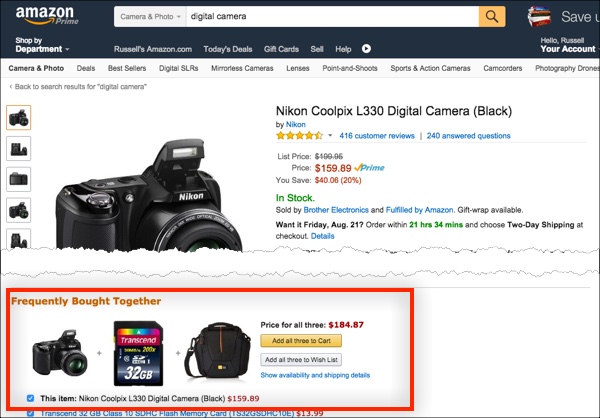
And Premium Subscriptions (recurring billing) like membership websites and other continuity offers make fantastic Profit Maximizer offers…

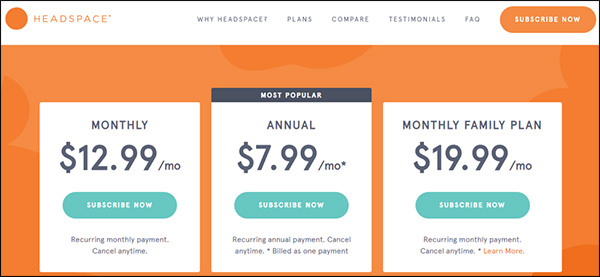
Hint: Any offer made after the initial sale is a Profit Maximizer.
They’re called Profit Maximizers because the revenue you get from these sales will be much more profitable than your Tripwire or Core Offer sales.
Remember: the single biggest expense most companies will incur is the cost of acquiring a new customer (which is the job of the Tripwire Offer).
Everything that happens after that increases the customer’s immediate and lifetime value.
So take some time to think about what you could be offering as an upsell or cross-sell. What could you bundle with your Core Offer? How can you incorporate a subscription or membership site into your business model?
Find your Profit Maximizer, and you begin to become unstoppable.
But there is one more way to grow…
Step 7: Create the Return Path
The last way to grow a business is to increase the number of transactions per customer.
Enter the Return Path.

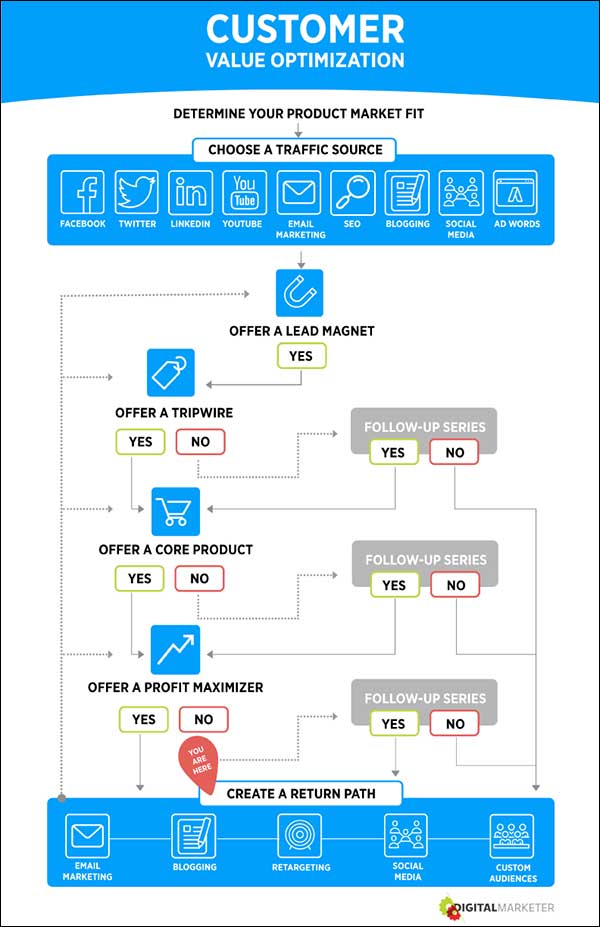
The goal of the Return Path is to have frequent, strategic communication with your buyers and prospects that cause them to buy again and again.
Because you have received their contact information through the Lead Magnet, you can continue marketing online to them.
You can offer new Lead Magnets, Tripwires, Core Offers, and Profit Maximizers because you have permission to market to them or bring them back to the Tripwire, Core Offer, or Profit Maximizer that they didn’t buy the first time around.
The Return Path is anything that brings the customer or prospect back more frequently, including…
- Email marketing
- Exit offers
- Organic social media (like Twitter, Facebook, and LinkedIn)
- Loyalty programs
- Content marketing
- Outbound sales calling
- Ad retargeting (More on ad retargeting here)
And that, my friends, is the system we have used (and continue to use) to grow DigitalMarketer and multiple other businesses in multiple industries.
It’s worked for single-member businesses and giant corporations like McDonald’s and Starbucks.
It works because it takes all the jigsaw pieces of digital marketing and fits them together in a way that fits.
And if you begin applying it the way I’ve just explained, it will help you (too!) to grow and scale your business.



